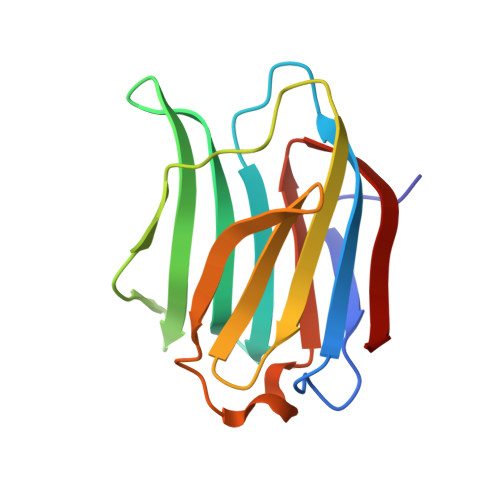Entropy-Entropy Compensation between the Protein, Ligand, and Solvent Degrees of Freedom Fine-Tunes Affinity in Ligand Binding to Galectin-3C.
Wallerstein, J., Ekberg, V., Ignjatovic, M.M., Kumar, R., Caldararu, O., Peterson, K., Wernersson, S., Brath, U., Leffler, H., Oksanen, E., Logan, D.T., Nilsson, U.J., Ryde, U., Akke, M.(2021) JACS Au 1: 484-500
- PubMed: 34467311
- DOI: https://doi.org/10.1021/jacsau.0c00094
- Primary Citation of Related Structures:
6RZF, 6RZG, 6RZH - PubMed Abstract:
Molecular recognition is fundamental to biological signaling. A central question is how individual interactions between molecular moieties affect the thermodynamics of ligand binding to proteins and how these effects might propagate beyond the immediate neighborhood of the binding site. Here, we investigate this question by introducing minor changes in ligand structure and characterizing the effects of these on ligand affinity to the carbohydrate recognition domain of galectin-3, using a combination of isothermal titration calorimetry, X-ray crystallography, NMR relaxation, and computational approaches including molecular dynamics (MD) simulations and grid inhomogeneous solvation theory (GIST). We studied a congeneric series of ligands with a fluorophenyl-triazole moiety, where the fluorine substituent varies between the ortho , meta , and para positions (denoted O, M, and P). The M and P ligands have similar affinities, whereas the O ligand has 3-fold lower affinity, reflecting differences in binding enthalpy and entropy. The results reveal surprising differences in conformational and solvation entropy among the three complexes. NMR backbone order parameters show that the O-bound protein has reduced conformational entropy compared to the M and P complexes. By contrast, the bound ligand is more flexible in the O complex, as determined by 19 F NMR relaxation, ensemble-refined X-ray diffraction data, and MD simulations. Furthermore, GIST calculations indicate that the O - bound complex has less unfavorable solvation entropy compared to the other two complexes. Thus, the results indicate compensatory effects from ligand conformational entropy and water entropy, on the one hand, and protein conformational entropy, on the other hand. Taken together, these different contributions amount to entropy-entropy compensation among the system components involved in ligand binding to a target protein.
Organizational Affiliation:
Biophysical Chemistry, Center for Molecular Protein Science, Department of Chemistry, Lund University, 221 00 Lund, Sweden.
















